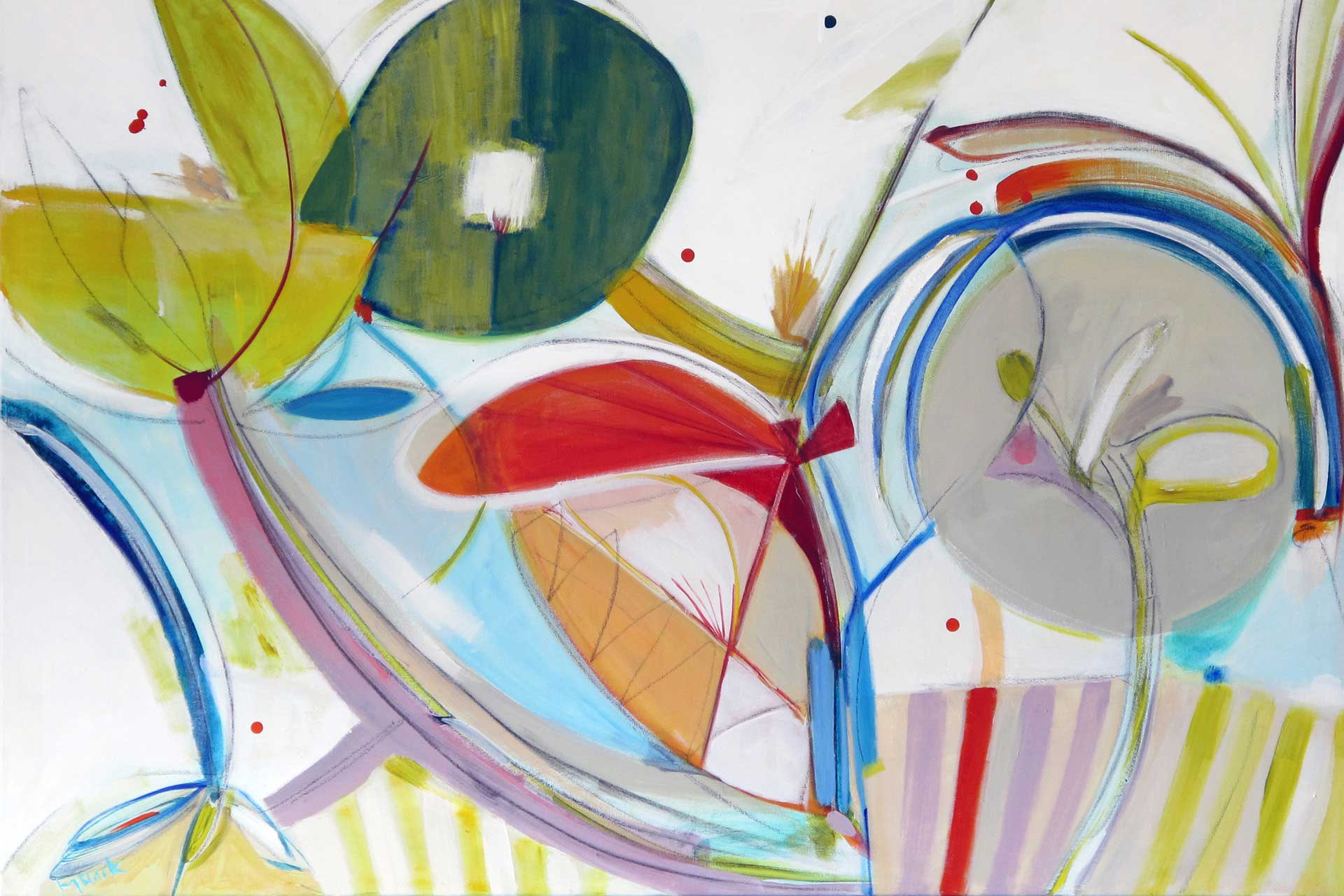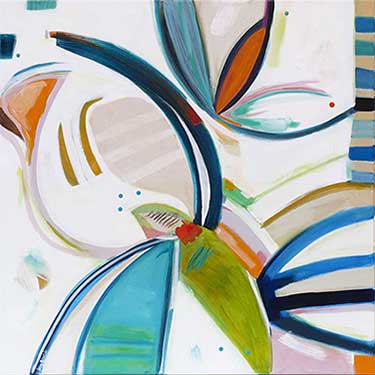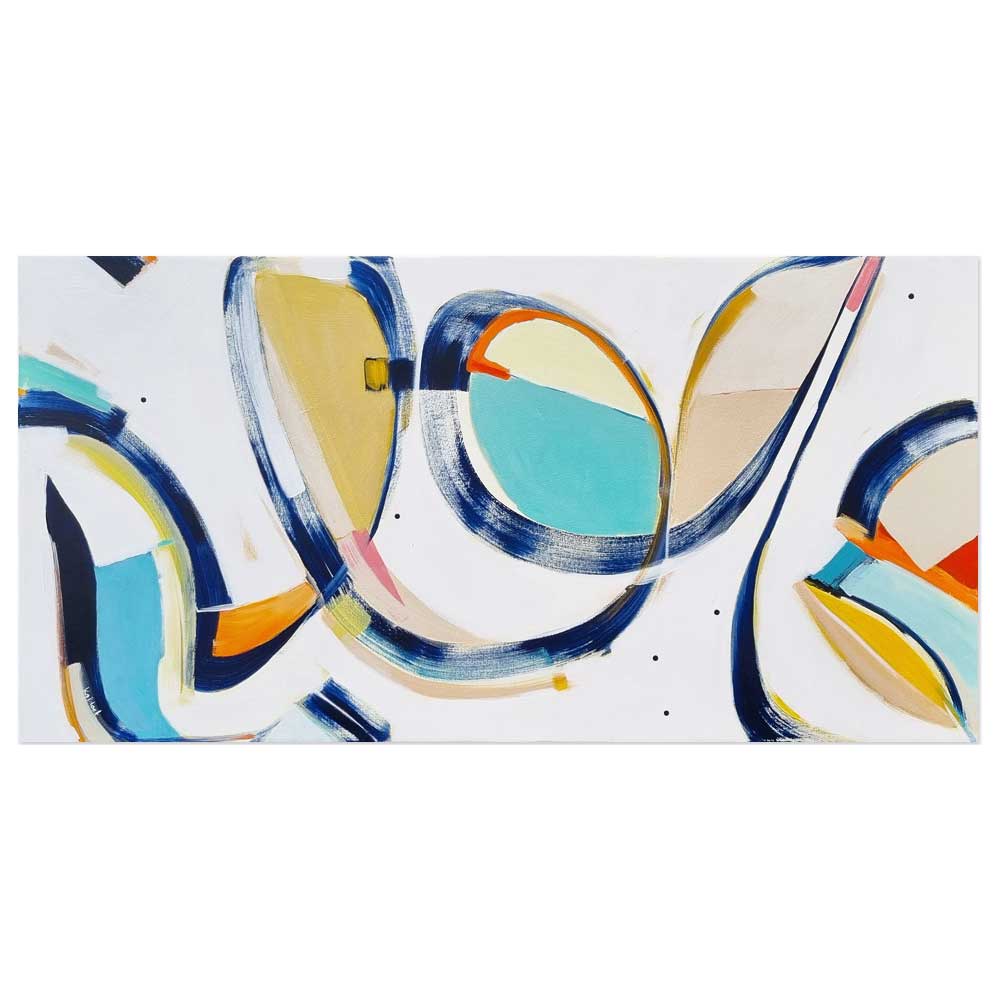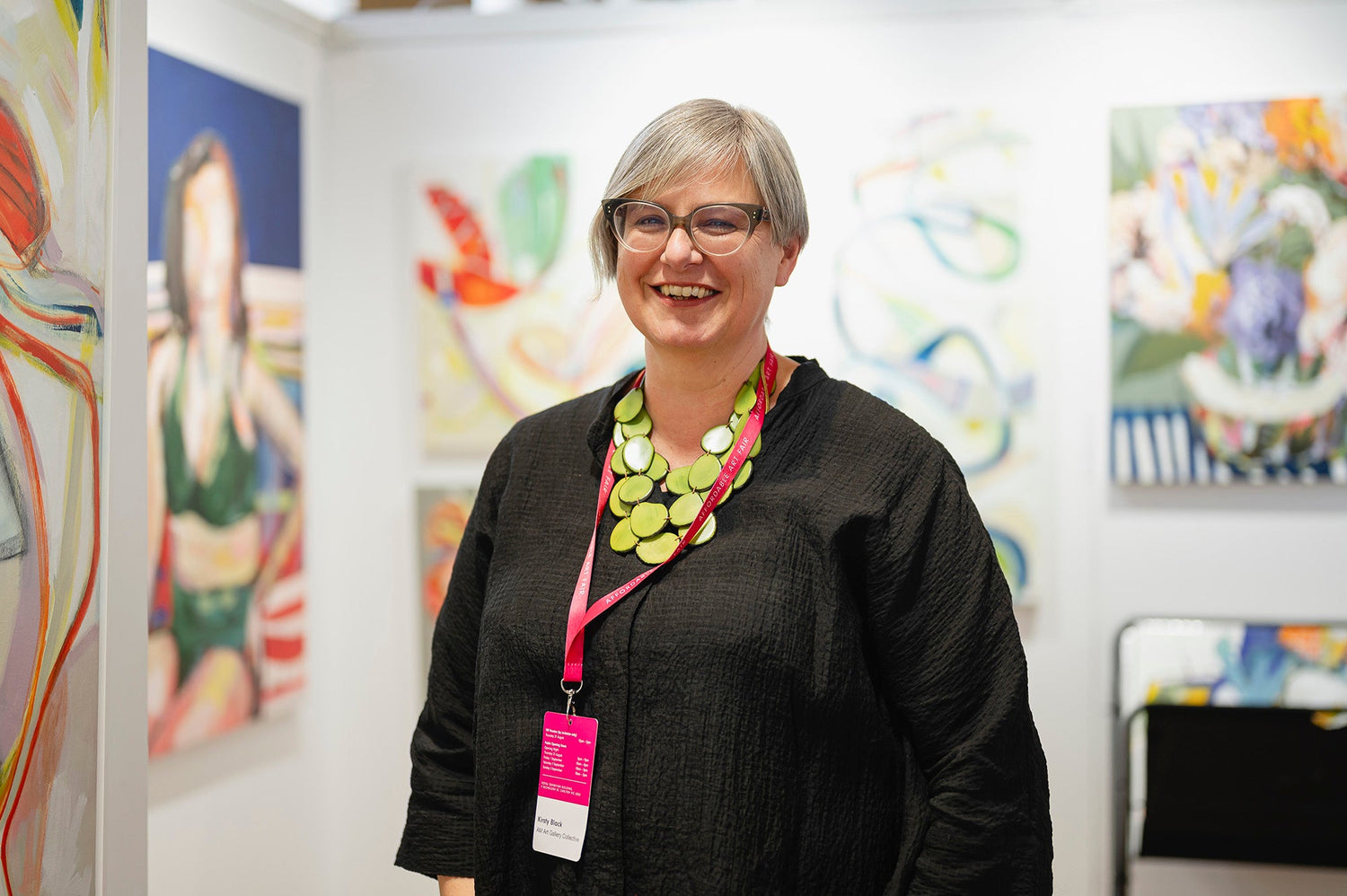Exploring the Vibrant World of Abstract Art in New Zealand. A Series of 30 Talking Points: 1 - 10
1. What is abstract art and how can it enhance my space?
Abstract art is a fascinating art form that eschews direct representation in favour of shapes, colours, forms, and gestural marks to create its effect. Unlike traditional visual art, abstract artwork does not attempt to accurately depict reality but instead uses the elements of art in ways that can evoke emotions, thoughts, or a sense of place without being tied to specific visual references. This genre of art, celebrated by pioneers like Wassily Kandinsky and Piet Mondrian, has evolved through various movements including abstract expressionism, minimalism, and op art, showcasing the diverse ways artists interpret the abstract.
Incorporating abstract art into a space can significantly enhance its aesthetic and emotional appeal. Abstract art prints and paintings offer a burst of colour or a dynamic composition that can complement the design of a room, acting as a statement piece or a subtle nod to the personal taste of the inhabitants. The beauty of abstract art lies in its ability to resonate differently with each viewer, making it a versatile choice for interior design. It can infuse a space with energy, tranquility, or a sense of sophistication, depending on the chosen artwork's style, colour scheme, and placement. By selecting abstract artwork that speaks to you, you not only create a visually appealing environment but also one that reflects your personality and invites conversation and contemplation.
2. How do I choose the right abstract art prints for my home?
Choosing the right abstract art prints for your home involves considering several factors to ensure that the artwork resonates with your personal style and complements your living space. First, think about the colour palette of the room where the art will be displayed. Abstract art is often celebrated for its use of colour, from the vibrant and energetic to the subdued and minimalistic. Selecting artwork whose colours harmonise with your room can create a cohesive look, whether you're seeking a pop of contrast or a seamless blend.
Next, consider the scale and orientation of the artwork. Large-scale abstract paintings can serve as focal points in a room, making bold statements that draw the eye and set the tone of the space. Smaller prints, on the other hand, can be grouped together to create a curated gallery wall that tells a story through colour and form.
The style of abstract art is another crucial factor. With styles ranging from the gestural brushstrokes of abstract expressionism to the precise geometric shapes of minimalism and the Bauhaus movement, the variety of abstract art available allows you to choose pieces that reflect your taste and the atmosphere you want to create.
Lastly, think about the emotional impact and the connection you feel with the artwork. Abstract art has the unique ability to evoke different feelings and interpretations, making personal connection a key consideration. Choose pieces that speak to you on an emotional level, whether they instil a sense of calm, inspire creativity, or simply make you happy.
3. Where can I find authentic New Zealand abstract artists?
Discovering authentic New Zealand abstract artists can be an exciting venture, as NZ is home to a vibrant and diverse art scene that reflects its unique cultural and physical landscape. One of the best places to start is local galleries and art exhibitions, which often feature the works of established and emerging NZ artists. Auckland, Wellington, and Christchurch, among other cities, have a rich array of galleries that showcase abstract art in various mediums and styles, from paintings and sculptures to abstract photography.
Art fairs and festivals are another avenue where you can explore contemporary abstract art and connect directly with artists. These events offer a glimpse into the latest trends and innovations in the art world, providing an opportunity to purchase original artwork and learn about the artists' techniques and inspirations.
Online platforms and social media have also become invaluable resources for discovering and purchasing abstract art from New Zealand artists. Websites dedicated to NZ art sales offer a wide range of abstract artworks, with detailed information about the artists and their works. Following NZ artists and galleries on social media platforms can also provide insights into the artists' processes and upcoming collections.
When searching for authentic abstract art, it's important to look for pieces that resonate with you and reflect the skill and creativity of the artist. Whether you're drawn to the dynamic expressions of abstract expressionism, the structured beauty of geometric abstraction, or the serene simplicity of minimalism, there's a wealth of talent in New Zealand's abstract art scene waiting to be explored.
4. How do I determine the value of abstract paintings for sale?
Determining the value of abstract paintings, whether eyeing pieces by New Zealand artists or international abstract expressionists like Mark Rothko, involves considering several key factors beyond just the aesthetic appeal. Firstly, the artist's reputation and standing in the art world play a crucial role. Established artists whose works have been displayed in reputable galleries or have a history of strong sales typically command higher prices. For emerging artists, look for those who have participated in respected exhibitions or received awards, as these can be indicators of their potential value.
The provenance of the artwork, or its history of ownership, can also significantly impact its value. Works that have a well-documented history, especially those previously part of esteemed collections or featured in significant exhibitions, are often more valuable. Additionally, the condition of the painting is crucial; works that have been well-maintained or professionally preserved tend to retain their value better than those that have suffered damage or deterioration.
Another factor to consider is the artwork's rarity and uniqueness. Limited edition abstract art prints or one-of-a-kind paintings can be more valuable than mass-produced works. Similarly, pieces that represent a pivotal moment in the artist's career or a significant period in the art movement they belong to (such as a prime example of post-painterly abstraction or a significant shift in the artist's use of colour or form) can be particularly valuable.
Lastly, market trends can influence the value of abstract art. Popularity in certain styles, such as minimalism or geometric abstraction, can fluctuate, affecting prices. Staying informed about current trends in the art world and specific movements like Bauhaus or Cubism can help in making educated decisions when purchasing abstract paintings.
5. What are the key differences between abstract expressionism and minimalism?
Abstract expressionism and minimalism are two influential movements in modern art, each representing a distinct approach to abstraction and evoking different emotional and intellectual responses.
Abstract expressionism, which emerged in the 1940s and 1950s, primarily in America with artists like Jackson Pollock and Mark Rothko, is characterised by its emphasis on spontaneous, automatic, or subconscious creation. It's a movement rooted in the expression of emotion through powerful, often gestural brushwork, and the use of colour to convey mood and atmosphere. Abstract expressionists sought to convey the tumultuous post-war emotions through their artworks, using abstraction as a means of personal expression and emotional liberation.
Minimalism, which gained prominence in the 1960s, represents a stark departure from the expressive nature of abstract expressionism. Minimalist artists like Donald Judd and Frank Stella focused on simplicity and purity of form, stripping down their works to the most basic elements of design—such as geometric shapes, lines, and solid colours. Minimalism emphasises the artwork itself, devoid of any external references or expressions, aiming to engage viewers in a more intellectual, contemplative interaction with the form, space, and material of the art.
The key differences lie in their approach and intent: abstract expressionism is more about the process of creation and the expression of deep, often complex emotions, while minimalism is about the essence of form and the viewer's experience of space and the artwork's physical presence. Both movements, however, have significantly influenced the trajectory of modern art, including the development of abstract art in New Zealand, shaping the practices of contemporary abstract artists working within these paradigms.
6. Can abstract artwork from NZ complement my existing art collection?
Abstract artwork from New Zealand can offer a unique and compelling addition to any art collection, bringing with it the rich cultural heritage and diverse natural beauty of the country. NZ abstract artists, much like their counterparts in movements such as Bauhaus or Cubism, draw inspiration from a wide range of influences, including the indigenous Maori culture, the country's varied landscapes, and the dynamic mix of Eastern and Western artistic traditions. This results in a wide array of abstract works, from paintings and sculptures to abstract photography, that can complement different styles and themes in an existing collection.
When integrating NZ abstract art into your collection, consider the interplay of colours, textures, and forms. Abstract works, with their focus on such elements, can create visual dialogues with other pieces in your collection, whether they are traditional landscapes, figurative paintings, or other abstract works. For example, an abstract painting with bold, vibrant colours can add a dramatic focal point to a collection dominated by more subdued tones, while a minimalist abstract piece can offer a calming counterbalance to more detailed works.
The key is to look for pieces that resonate with your personally and that can create a cohesive yet dynamic aesthetic when displayed alongside your existing artworks. Whether it's the fluid forms of abstract expressionism, the geometric precision of De Stijl, or the conceptual simplicity of minimalism, NZ abstract art offers a range of possibilities to enhance and diversify your art collection.
7. What should I look for when buying my first piece of canvas art?
When venturing into the realm of purchasing your first piece of canvas art, especially if you're drawn to abstract artwork, there are several key aspects to consider that will ensure your acquisition is both personally satisfying and a worthy addition to your living space or art collection.
Emotional Connection: The most vital element when choosing an abstract painting is the emotional resonance you feel with the piece. Abstract art, celebrated for its ability to convey emotion through colour, form, and texture rather than detailed depictions, should speak to you on an intuitive level. Whether it evokes a sense of calm, joy, curiosity, or nostalgia, the artwork should inspire a personal connection, making it more than just a decorative piece.
Visual Impact: Consider the visual impact of the artwork within your intended space. Abstract canvas art, known for its versatility, can serve as a statement piece or complement the existing decor and colour scheme of a room. Pay attention to the size and orientation of the piece; large-scale works can create focal points in a room, while smaller works might best suit a gallery wall or intimate space.
Artist's Background and Style: Gaining insight into the artist’s background, their inspirations, and the movements they draw from, such as abstract expressionism, minimalism, or cubism, can add depth to your appreciation of the artwork. New Zealand artists, for instance, might infuse their work with elements reflective of the country’s landscape and cultural heritage, offering unique perspectives within the broader spectrum of abstract art.
Quality and Authenticity: Ensure the artwork is of high quality, with attention to the durability of the canvas and the type of paint used. For original artworks, a certificate of authenticity from the artist or gallery can verify its provenance and protect your investment.
Display Considerations: Finally, think about how you will display the artwork. The right frame, lighting, and placement can significantly enhance the visual appeal and impact of abstract canvas art, making it truly integral to your space.
8. How do artists in New Zealand interpret colour in abstract painting?
Colour in abstract painting is not just a visual element; it's a language that conveys emotions, ideas, and narratives. New Zealand artists, operating within a rich cultural and natural landscape, bring a unique interpretation to the use of colour in their abstract works, reflecting the country’s diverse environments and cultural influences.
Cultural Influence: The vibrant heritage of the Maori culture, with its powerful symbolism and connection to the land, sea, and sky, influences NZ artists’ colour palettes. Bold, earthy tones, serene blues and greens, and the vivid reds and blacks found in traditional Maori art can often find echoes in the abstract paintings of New Zealand artists, infusing their work with a sense of place and identity.
Natural Inspiration: The breathtaking landscapes of New Zealand, from the luminous glow of the Southern Alps at dawn to the deep, mysterious greens of the Fiordland rainforests, provide a limitless palette for abstract artists. The dynamic interplay of light, shadow, and colour observed in these natural settings often translates into abstract works that capture the essence of New Zealand’s beauty in a universal language of colour.
International Movements: Influences from global art movements such as fauvism, known for its wild, vibrant colours, and abstract expressionism, with its emotional depth conveyed through colour, are evident in the work of NZ abstract artists. These influences merge with local sensibilities to create artwork that speaks both to international art trends and to the unique visual and emotional landscapes of New Zealand.
Personal Exploration: Ultimately, each artist’s interpretation of colour is a deeply personal journey. Whether drawing from the intensity of Mark Rothko’s colour fields, the geometric colour blocks of Piet Mondrian, or the subtle tonal variations of minimalism, New Zealand's abstract artists use colour to explore and express their inner worlds, inviting viewers into a shared space of discovery and contemplation.
Abstract painting in New Zealand is a vibrant testament to the power of colour as a medium for expression and connection, bridging the local and the universal, the personal and the collective.
9. Are there any emerging New Zealand artists working in non-objective art?
In the vibrant and ever-evolving landscape of New Zealand's art scene, a new generation of artists is making waves, particularly in the realm of non-objective art. This style, which eschews representational forms for the exploration of pure colour, shape, and texture, has found a unique voice in the country, drawing on its rich cultural and natural heritage while engaging with the global discourse on abstraction.
Emerging NZ artists in this field often bring a fresh perspective to the principles of non-objective art, infusing their works with a distinctly Kiwi spirit—whether through the use of indigenous materials, the incorporation of Maori or Pasifika patterns and symbols in abstract ways, or through colour palettes inspired by the country's diverse landscapes. These artists are not only exploring the aesthetic possibilities of non-objective art but are also questioning and expanding its conceptual boundaries.
The support from local galleries, art schools, and cultural institutions has been instrumental in nurturing these emerging talents. Auckland, Wellington, and Christchurch, with their dynamic art scenes, host numerous exhibitions and art fairs showcasing the works of up-and-coming abstract artists. Additionally, online platforms and social media have become crucial in promoting these artists, allowing them to reach a wider audience both domestically and internationally.
For art collectors and enthusiasts looking to discover emerging New Zealand artists working in non-objective art, visiting local galleries, attending graduate shows at art schools, and exploring artist-led spaces can be particularly rewarding. These venues often offer the first glimpse of the innovative directions in which these artists are taking abstract art, highlighting their contributions to the ongoing dialogue around abstraction and its place in contemporary art.
10. What was the first abstract work and why is it important?
The question of the first abstract work is a subject of considerable debate among art historians, but it is widely acknowledged that abstract art as a conscious art movement began in the early 20th century. Two artists often credited with creating some of the first works of abstract art are Wassily Kandinsky and Kazimir Malevich.
Wassily Kandinsky, a Russian artist, is frequently cited for his pivotal role in the development of abstract art. Around 1911, Kandinsky began to produce compositions that eschewed representational forms, focusing instead on the emotional and spiritual qualities conveyed through colour and abstract shapes. His work "Composition VII" (1913) is often hailed as a landmark in the evolution of abstract painting, demonstrating his belief that art could express the inner life of the artist as directly as music.
Kazimir Malevich's "Black Square" (1915) is another contender for the title of the first abstract work, marking a radical break with all previous forms of painting. Malevich's Suprematism, the movement founded by him, focused on basic geometric forms and a limited colour palette to explore the concept of pure artistic feeling rather than depict the visible world.
The significance of these early abstract works lies in their revolutionary break from the tradition of representational painting, opening up new avenues for artistic expression. They challenged the notion that art must imitate life, instead proposing that art could exist purely as an aesthetic experience or an expression of spiritual truths. This shift not only paved the way for the myriad forms of abstract art that would follow but also fundamentally altered the course of modern art, influencing countless artists and movements from abstract expressionism to minimalism and beyond.
The exploration and acceptance of abstract art, including the impactful contributions of pioneers like Kandinsky and Malevich, have been instrumental in expanding the definition of art. It encouraged a more inclusive understanding of what art could be, encompassing a range of styles from the geometric precision of cubism and the intuitive expressions of abstract expressionism to the conceptual rigour of minimalism and the pattern and decoration movements.
These foundational works and the movements they inspired have had a lasting impact on the art world, including the vibrant scene of abstract art in New Zealand, where artists continue to explore and push the boundaries of what abstract art can express.
Conclusion
Throughout our discussion on abstract art, we've touched upon various aspects from its definition and significance to the specific influences shaping New Zealand's abstract art scene. This exploration has highlighted the diverse interpretations and expressions within abstract art, showcasing how it serves as a medium for both artists and viewers to engage with deeper emotional and conceptual layers.
For those interested in exploring or purchasing abstract art, particularly pieces that reflect the unique landscape and cultural heritage of New Zealand, Kirsty Black Studio offers a range of compelling options. We encourage you to visit the studio's website to view her collection of abstract paintings and prints. It's an opportunity to connect with the vibrant world of abstract art and find pieces that resonate with your personal or professional spaces.
Consider starting or enhancing your art collection by exploring the works available at Kirsty Black Studio, where the richness of abstract art is vividly on display.
Contact Us Today to Explore Our Collection or Discuss Your Artistic Needs!
📧 Email: kirsty@kirstyblackstudio.com
📞 Phone: +64 21 549 193
📍 Visit Our Studio: Maraetai, Auckland, New Zealand (Please phone ahead to make an appointment)









